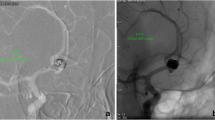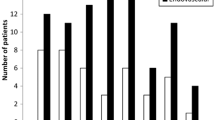Abstract
Introduction
The purpose of this paper is to investigate the clinical significance of postinterventional subarachnoid hyperdensities (PSH) after endovascular mechanical thrombectomy in acute ischemic stroke.
Methods
We analysed clinical and radiological data of 113 consecutive patients who received postinterventional CT scans within 4.5 h after mechanical thrombectomy.
Results
PSH was present in 27 of 113 patients (24 %). Extravasation of contrast agent was observed during intervention in only 6 of 27 cases (22 %). There was consecutive haemorrhagic transformation in four patients with PSH (p = 0.209, Fisher’s exact test). Preinterventional predictors for the occurrence of PSH in our series were a long interval between clinical onset and recanalization (p = 0.028), a long procedure time (p = 0.010), and a high number of recanalization attempts (p = 0.001). PSH had no significant impact on clinical outcome (modified Rankin Scale) at discharge (p = 0.419) or at 3 months (p = 0.396). There were no significant correlations between PSH and thrombectomy devices (Solitaire: p = 0.433, Trevo Pro: p = 0.124).
Conclusion
PSH after endovascular mechanical thrombectomy in acute ischemic stroke are likely to occur in complicated cases in which more than one revascularisation attempt is performed. PSH per se do not appear to be associated with an impaired clinical outcome or an elevated risk for consecutive haemorrhage.





Similar content being viewed by others
References
Yilmaz U, Walter S, Körner H, Papanagiotou P, Roth C, Simgen A, Behnke S, Ragoschke-Schumm A, Fassbender K, Reith W (2014) Peri-interventional subarachnoid hemorrhage during mechanical thrombectomy with stent retrievers in acute stroke: a retrospective case–control study. Clin Neuroradiol
Kurre W, Aguilar-Pérez M, Schmid E, Sperber W, Bäzner H, Henkes H (2014) Clinical experience with the pREset stent retriever for the treatment of acute ischemic stroke-a review of 271 consecutive cases. Neuroradiology
Yoon W, Jung MY, Jung SH, Park MS, Kim JT, Kang HK (2013) Subarachnoid haemorrage in a multimodal approach heavily weighted toward mechanical thrombectomy with solitaire stent in acute stroke. Stroke 44(2):414–419
Parrilla G, García-Villalba B, Espinosa de Rueda M, Zamarro J, Carrión E, Hernández-Fernández F, Martín J, Hernández-Clares R, Morales A, Moreno A (2012) Haemorrage/contrast staining areas after mechanical intra-arterial thrombectomy in acute ischemic stroke: imaging findings and clinical significance. AJNR Am J Neuroradiol 33(9):1791–1796
Dorn F, Stehle S, Lockau H, Zimmer C, Liebig T (2012) Endovascular treatment of acute intracerebral artery occlusions with the solitaire stent: single-centre experience with 108 recanalization procedures. Cerebrovasc Dis 34(1):70–77
Machi P, Costalat V, Lobotesis K, Maldonado IL, Vendrell JF, Riquelme C, Bonafé A (2012) Solitaire FR thrombectomy system: immediate results in 56 consecutive acute ischemic stroke patients. J Neurointerv Surg 4(1):62–66
Shi ZS, Liebeskind DS, Loh Y, Saver JL, Starkman S, Vespa PM, Gonzalez NR, Tateshima S, Jahan R, Feng L, Miller C, Ali LK, Ovbiagele B, Kim D, Duckwiler GR, Viñuela F, UCLA Endovascular Stroke Therapy Investigators (2010) Predictors of subarachnoid hemorrhage in acute ischemic stroke with endovascular therapy. Stroke 41(12):2775–2781
Smith WS (2006) Safety of mechanical thrombectomy and intravenous tissue plasminogen activator in acute ischemic stroke. Results of the multi Mechanical Embolus Removal in Cerebral Ischemia (MERCI) trial, part I. AJNR Am J Neuroradiol 27:1177–1182
Pexman JH, Barber PA, Hill MD, Sevick RJ, Demchuk AM, Hudon ME, Hu WY, Buchan AM (2001) Use of the Alberta Stroke Program Early CT Score (ASPECTS) for assessing CT scans in patients with acute stroke. AJNR Am J Neuroradiol 22(8):1534–1542
Nikoubashman O, Reich A, Gindullis M, Frohnhofen K, Pjontek R, Brockmann MA, Schulz JB, Wiesmann M (2014) Clinical significance of post-interventional cerebral hyperdensities after endovascular mechanical thrombectomy in acute ischaemic stroke. Neuroradiology 56(1):41–50
Trouillas P, von Kummer R (2006) Classification and pathogenesis of cerebral haemorrages after thrombolysis in ischemic stroke. Stroke 37(2):556–561
Harnek J, Zoucas E, Carlemalm E, Cwikiel W (1999) Differences in endothelial injury after balloon angioplasty, insertion of balloon-expanded stents or release of self-expanding stents: an electron microscopic experimental study. Cardiovasc Intervent Radiol 22(1):56–61
Banks WA (2009) Characteristics of compounds that cross the blood–brain barrier. BMC 9(Suppl 1):S3
Niego B, Freeman R, Puschmann TB, Turnley AM, Medcalf RL (2012) t-PA-specific modulation of a human blood–brain barrier model involves plasmin-mediated activation of the Rho kinase pathway in astrocytes. Blood 119(20):4752–4761
Lummel N, Schulte-Altedorneburg G, Bernau C, Pfefferkorn T, Patzig M, Janssen H, Opherk C, Brückmann H, Linn J (2014) Hyperattenuated intracerebral lesions after mechanical recanalization in acute stroke. AJNR 35(2):345–351
Khan SM, Ho DW, Lazar JM, Marmur JD (2014) Cerebral contrast retention after difficult cardiac catheterization: Case report. SAGE Open Medical Case Reports 2:2050313X14530283
Stone JA, Sharp S, Castillo M (1999) Subarachnoid contrast enhancement mimicking subarachnoid hemorrhage after coronary angiography. AJR 172:831–832
Velden J, Milz P, Winkler F, Seelos K, Hamann GF (2003) Nonionic contrast neurotoxicity after coronary angiography mimicking subarachnoid hemorrhage. Eur Neurol 49:249–251
Brockmann C, Scharf J, Nölte IS, Seiz M, Groden C, Brockmann MA (2010) Dual-energy CT after peri-interventional subarachnoid haemorrhage: a feasibility study. Clin Neuroradiol 20(4):231–235
Ethical standards and patient consent
We declare that this study has been approved by the Ethics Committee of the University Hospital of Aachen and has therefore been performed in accordance with the ethical standards laid down in the 1964 Declaration of Helsinki and its later amendments. Patient consent was waived due to the retrospective nature of this study.
Acknowledgments
The authors would like to thank Valérie Schöffers, Katharina Frohnhofen and Pola Heimann for their helpful contributions to this article.
Conflict of interest
We declare that we have no conflict of interest.
Author information
Authors and Affiliations
Corresponding author
Rights and permissions
About this article
Cite this article
Nikoubashman, O., Reich, A., Pjontek, R. et al. Postinterventional subarachnoid haemorrhage after endovascular stroke treatment with stent retrievers. Neuroradiology 56, 1087–1096 (2014). https://doi.org/10.1007/s00234-014-1424-1
Received:
Accepted:
Published:
Issue Date:
DOI: https://doi.org/10.1007/s00234-014-1424-1




